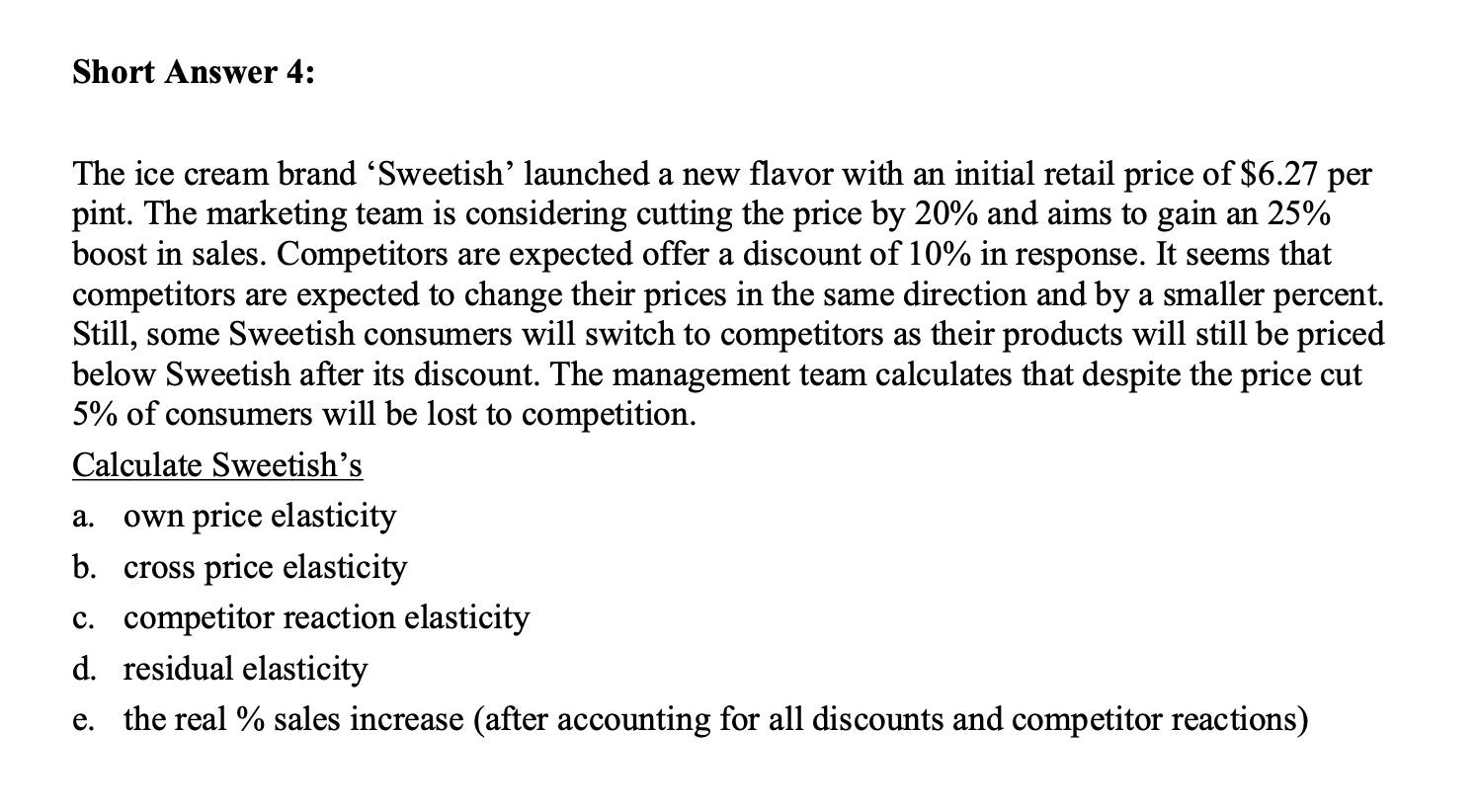Calculate Sweetish’s a. own price elasticity b. cross price elasticity c. competitor reaction elasticity d. residual elasticity e. the real % sales increase (after accounting for a... Calculate Sweetish’s a. own price elasticity b. cross price elasticity c. competitor reaction elasticity d. residual elasticity e. the real % sales increase (after accounting for all discounts and competitor reactions)

Understand the Problem
The question is asking to calculate various types of elasticities related to the pricing strategy of the ice cream brand 'Sweetish'. This includes own price elasticity, cross price elasticity, competitor reaction elasticity, residual elasticity, and the real percentage sales increase after accounting for discounts and competition. It requires understanding of economic concepts related to pricing and consumer behavior.
Answer
a. $-1.25$ b. $0.5$ c. $0.5$ d. $20\%$ e. $20\%$
Answer for screen readers
a. Own price elasticity: $-1.25$
b. Cross price elasticity: $0.5$
c. Competitor reaction elasticity: $0.5$
d. Residual elasticity: $20%$
e. Real % sales increase: $20%$
Steps to Solve
- Calculate Own Price Elasticity
Own price elasticity is calculated using the formula:
$$ EP = \frac{%\ \text{change in quantity demanded}}{%\ \text{change in price}} $$
Here, Sweetish plans to cut its price by 20% and aims for a 25% increase in sales.
So,
$$ EP = \frac{25%}{-20%} = -1.25 $$
- Calculate Cross Price Elasticity
Cross price elasticity measures the responsiveness of the quantity demanded of one good when the price of another good changes.
Given that competitors are cutting their prices by 10%, we can calculate:
$$ CPE = \frac{%\ \text{change in quantity demanded of Sweetish}}{%\ \text{change in price of competitors}} $$
Using the previous values, if we assume that all 25% of the sales increase is affected by competitor price changes:
$$ CPE = \frac{-5%}{-10%} = 0.5 $$
- Calculate Competitor Reaction Elasticity
This elasticity looks at how much competitors adjust their prices. Given that Sweetish is cutting its price by 20% and competitors respond with a 10% decrease, we have:
$$ CRE = \frac{%\ \text{change in competitor price}}{%\ \text{change in Sweetish price}} = \frac{-10%}{-20%} = 0.5 $$
- Calculate Residual Elasticity
Residual elasticity considers the percentage of consumers lost due to competition:
$$ RE = %\ \text{change in quantity demanded} + %\ \text{change in competitors price - percentage of sales lost to competition} $$
Assuming a 25% increase but losing 5% of sales due to competition:
$$ RE = 25% - 5% = 20% $$
- Calculate Real % Sales Increase
Finally, the real percentage sales increase after accounting for all factors can be calculated with adjustments for the discounts and competition:
$$ Real\ % \text{increase} = 25% - 5% = 20% $$
a. Own price elasticity: $-1.25$
b. Cross price elasticity: $0.5$
c. Competitor reaction elasticity: $0.5$
d. Residual elasticity: $20%$
e. Real % sales increase: $20%$
More Information
- The own price elasticity indicates that a 1% increase in price would lead to a 1.25% decrease in quantity demanded, showing a relatively elastic demand for Sweetish's ice cream.
- Cross price elasticity of 0.5 indicates a positive relationship with competitors; as competitor prices drop, Sweetish's demand slightly increases.
- Residual elasticity considers the actual market conditions when estimating demand and competition impacts.
Tips
- Confusing the signs in elasticity calculations; always remember that a price increase typically leads to a decrease in quantity demanded.
- Misinterpreting the percentage changes; ensure to accurately apply the changes due to discounts and competitor actions.
AI-generated content may contain errors. Please verify critical information